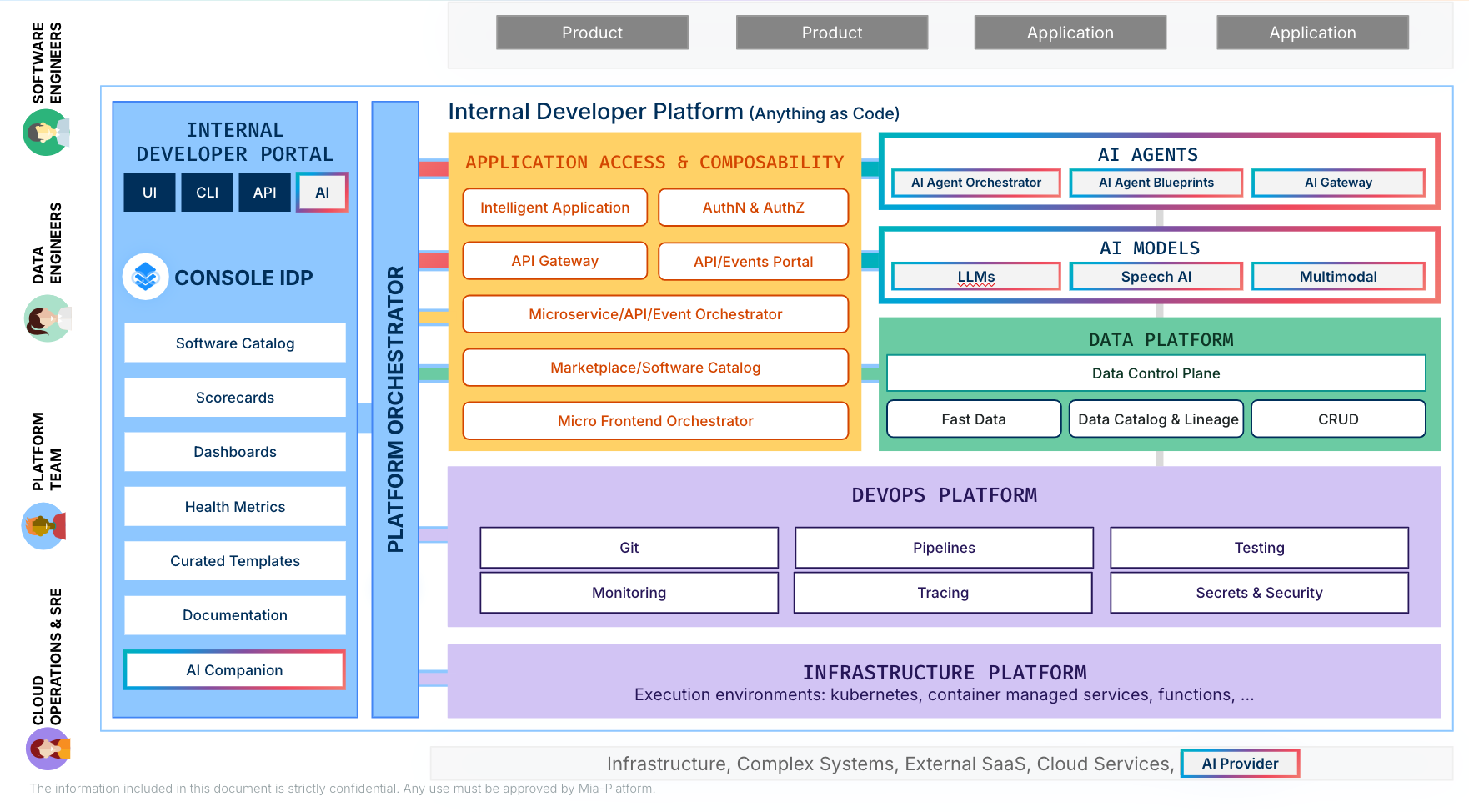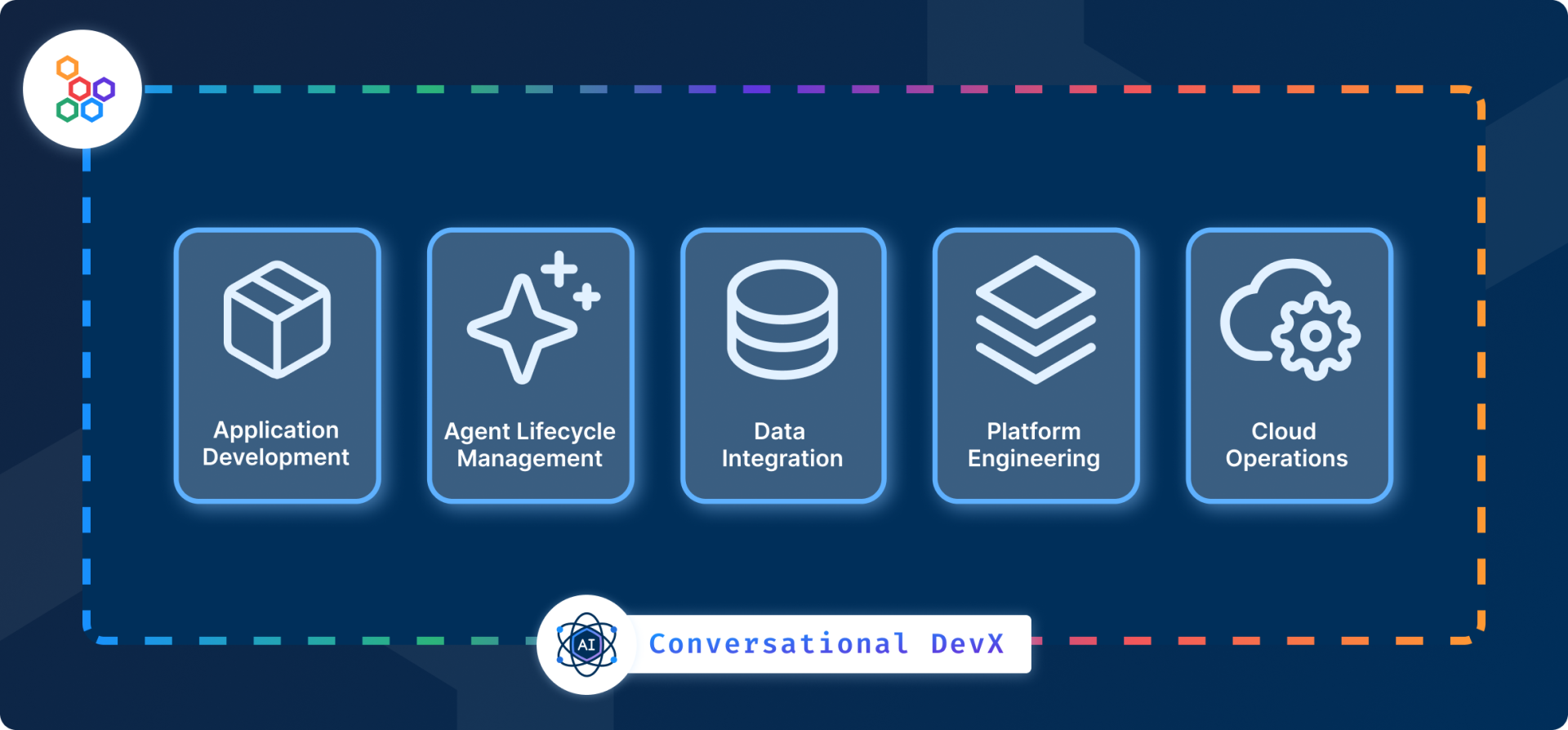Mia-Platform Overview
Mia-Platform Overview: Accelerating Your Digital Future
In an ever-evolving digital landscape, speed of innovation, operational efficiency and the ability to leverage the true potential of data are fundamental for competitiveness. Mia-Platform is your cloud-native Platform Builder for building and managing your custom digital platform, designed to eliminate complexities and accelerate your journey towards digital excellence.
Developed by developers for developers, Mia-Platform consolidates all necessary tools into a single ecosystem, offering guided paths ("golden paths") through the complex landscape of cloud-native technologies. Our goal is simple: simplify the software development lifecycle (SDLC), allowing you to focus on business logic rather than infrastructure.

1. Application Development: Develop Faster, with Intelligence
The challenge: Building scalable, reusable and performant cloud-native applications is often a slow and fragmented process, requiring an enormous amount of time and resources to manage underlying complexities.
The Mia-Platform solution: Mia-Platform transforms application development into a self-service and AI-Native experience. Forget bottlenecks and duplicated efforts. With Mia-Platform, you can:
-
Create modular and reusable microservices with a few clicks, starting from predefined templates or importing them from an artifact registry, ensuring standardization and quality from day one.
-
Leverage an ever-expanding software catalog (the Runtime Components) full of ready-to-use plugins, templates and applications, drastically accelerating the development of your products.
-
Design and orchestrate Microfrontend Composer applications (such as backoffices or complex user interfaces) in a few clicks, using low-code functionalities to read and write data in real-time.
-
Manage the entire end-to-end lifecycle of cloud-native applications with full autonomy and security, from design to configuration, all the way to deployment.
The result: Increased productivity for development teams, reduced time-to-market and the freedom to innovate with agility, building applications that respond rapidly to business needs.
2. Platform Engineering: Industrialize Software Delivery with Governance
The challenge: Managing complex cloud-native infrastructures and ensuring a fluid Developer Experience (DevX) are arduous tasks that often heavily burden Platform Engineering and DevOps teams, increasing cognitive load and slowing down delivery.
The Mia-Platform solution: By enabling the construction of your Internal Developer Platform (IDP), Mia-Platform allows you to industrialize software development and deployment. Through a Platform Engineering approach, Mia-Platform enables you to:
-
Reduce cognitive load on cloud-native complexity, providing an abstract and intuitive environment for developers.
-
Define and manage environment variables at different levels, with full control over user permissions and visibility, ensuring security and consistency.
-
Manage all configurations of your microservices, abstracting their complexity thanks to powerful low-code and no-code functionalities.
-
Automate the deployment of your microservices on multi-cloud providers and on-premise environments with a few clicks, monitoring their resource usage in real-time to optimize performance.
-
Expose all APIs through an API Gateway of your choice, in a simple and secure way, ensuring controlled and governed access.
The result: Greater visibility, traceability and monitoring of the entire DevOps cycle. Your Platform Engineering teams can establish standards, ensure governance and make infrastructure transparent, allowing developers to focus on value creation.
3. Data Integration: Unlock the True Power of Your Data in Real-Time
The challenge: Integrating data from disparate sources, ensuring quality and real-time availability are common obstacles that prevent organizations from gaining a unified view and fully leveraging the value of their information assets.
The Mia-Platform solution: Mia-Platform allows you to build your Digital Integration Hub (DIH), a cutting-edge solution as a reference implementation. This unique architecture combines the best of Data Mesh and Data Fabric, offering a holistic approach to data management. With Mia-Platform, you can:
-
Leverage a Data Fabric solution to govern the entire data lifecycle, from collection to exposure.
-
Project data from your legacy systems and create Single Views, unified views of a data subset with a specific purpose, to reduce access latency and increase data availability.
-
Connect your cloud-native platform with existing systems, decoupling and offloading legacy systems and serving real-time data 24/7.
-
Aggregate data from different sources and make it available in near real-time, improving the availability and accessibility of crucial business information.
The result: Aggregated data available in real-time, a unified business view and the ability to power strategic decisions and AI-native applications with always up-to-date information.
4. AI Agent Lifecycle: Architect, Orchestrate and Govern Intelligent Systems
The Challenge: The promise of Generative AI is vast, but the path to production is fraught with peril. Organizations struggle to bridge the chasm between powerful Large Language Models (LLMs) and their proprietary data, orchestrate intelligent agents and govern the entire lifecycle securely in production environments.
The Mia-Platform Solution: Mia-Platform provides a comprehensive framework to build, orchestrate and govern end-to-end AI-native systems as a core function of the platform. We demystify Generative AI adoption, allowing you to:
-
Build Context-Aware RAG Applications: Develop sophisticated Retrieval-Augmented Generation applications that empower LLMs to reason with your private, proprietary data sources, delivering answers that are not only accurate but deeply contextualized.
-
Forge a Foundation of AI-Ready Data: Leverage the Digital Integration Hub to prepare and serve a continuous stream of high-quality, fresh and reliable data, ensuring your AI models operate with information that is secure and compliant by design.
-
Orchestrate Intelligent Agent & Multi-Agent Systems: Move beyond single-shot prompts. Design, coordinate and monitor complex workflows where multiple AI agents collaborate to execute distributed tasks and solve multifaceted business problems.
-
Govern Every Interaction with a Centralized AI Gateway: Secure, manage and optimize all interactions with AI models through a unified control plane. Provide standardized interfaces to the market's leading foundation models (FMs).
-
Achieve Digital Sovereignty with Self-Hosted LLMs: Retain absolute control over your data and intellectual property by deploying and managing LLMs within your own private infrastructure.
The Result: Transform AI from a theoretical asset into a tangible engine for business value. Ship intelligent, secure and seamlessly integrated applications at speed, turning your data into a powerful competitive differentiator.
5. Cloud Operations: Command Your Cloud with Confidence and Efficiency
The Challenge: Taming the chaos of multi-cloud and hybrid environments is a constant battle. The silent creep of operational overhead, the struggle to enforce security consistently and the pressure to optimize costs can stifle innovation and expose the business to risk.
The Mia-Platform Solution: Mia-Platform offers a centralized command center to master your cloud-native infrastructure, embedding best practices for security, reliability and optimization by default. This empowers you to:
-
Codify Your Infrastructure for Unshakeable Consistency (IaC): Manage and provision your entire infrastructure through machine-readable configurations. Guarantee that every deployment is repeatable, scalable and version-controlled.
-
Command Your Multi & Hybrid Cloud Fleet: From a single pane of glass, control and orchestrate resources across multiple cloud providers and on-premises environments with unified management.
-
Achieve End-to-End Observability: Gain deep, actionable insights into the health, performance and security of your platform and applications. Turn data into decisive operational intelligence.
-
Embed Security into the Fabric of Your Platform (Security Guardrails): Deploy automated policies and controls that enforce security best practices system-wide, ensuring you stay compliant without sacrificing speed.
-
Master Cloud Economics and Sustainability (FinOps & GreenOps): Take command of your cloud spend with intelligent cost optimization and drive environmental sustainability by reducing the carbon footprint of your operations.
The Result: Achieve a state of operational excellence. Your teams can manage complexity with ease, fortify your security posture, control costs and transform your cloud infrastructure from a cost center into a strategic asset.
Why Mia-Platform?

Mia-Platform supports you in creating, maintaining and evolving your digital platform tailored to your business. Our platform is the catalyst for:
-
Platform Engineering: Industrializing software development and reducing cognitive load by building your Internal Developer Platform.
-
Composable Approach: Accelerating the deployment of new features and products thanks to a software catalog of ready-to-use microservices and applications, promoting self-service and reuse of existing assets. This helps you reduce time-to-market and ensure clear governance.
-
The True Power of Data: Building a Digital Integration Hub based on Fast Data, ensuring real-time data ingestion, aggregation and availability from various sources, decoupling legacy systems and improving information availability.
-
AI-Native Systems: Architect, orchestrate and govern end-to-end intelligent systems to transform AI from a theoretical asset into a tangible engine for business value.
-
Cloud Operations Excellence: Command your cloud infrastructure with confidence and efficiency, embedding security, reliability and cost optimization into your operations by default.
Mia-Platform Products: Your Integrated Ecosystem
Mia-Platform provides you with a suite of products that support platform governance, enable composable business and facilitate coexistence with legacy systems.
Core Products: These products form the backbone of Mia-Platform and are the main solutions used daily by our customers:
-
Mia-Platform Console: The heart of the suite, Mia-Platform Console industrializes and governs cloud-native development and operations, facilitating platform engineering and application development to optimize DevX and accelerate product teams' delivery.
-
Mia-Platform Runtime Components: Accelerate the creation of new applications through reuse and composition of components.
-
Software Catalog: A centralized solution for tracking and managing all software within your organization's ecosystem. It includes a public catalog of ready-to-use components and a private catalog for internal, reusable assets.
-
Mia-Platform Fast Data: Adopt a Digital Integration Hub architecture with a Data Fabric approach to unlock the full potential of real-time data. It provides a unified data control plane, enabling data ingestion from any source, data synchronization and the creation of data products and APIs for rapid, secure data access.
Additional Components: These components contribute to the realization of specific tasks within your products and are available through Mia-Platform Runtime Components:
-
API Management: With API Gateway and API Portal you can simplify API management, routing requests, applying security policies, and offering a self-service interface for documentation and testing.
-
Mia-Platform Microfrontend Composer: Create custom CMSs, or generic User Interfaces, with the ability to compose custom pages, putting whatever web component coming from the back-kit library or from a custom component library.
-
Mia-Platform External Developer Portal: A complete access point to your company's APIs for your partners and providers, containing live and testable API documentation and allowing standardization in usage methods.
-
Mia-Platform Flow Manager: A saga orchestrator, capable of managing flows structured using the architectural pattern named Saga Pattern, particularly the Command/Orchestration approach.
-
RAG Template: Build and run your own conversational RAG application using LangChain and FastAPI to connect with your data.
-
AI-Powered SDLC Tool: Enhance quality and accelerate development with AI-powered requirement evaluation, test coverage estimation and compliance checks for industry standards (e.g., IEC 62304, AI Act).
-
AI-Compliance for Data Catalog: Empower non-technical roles with an AI Assistant to explore and understand Data Catalog metadata using natural language, simplifying compliance and audits.
-
Infrastructure Projects: A dedicated Project type for Operations teams to define, version and deploy infrastructure resources with consistency and control, following the Infrastructure as Code paradigm.
-
Infrastructure Resources: Extend the Console's capabilities by defining any custom infrastructure object—from Kubernetes CRDs to Lambda functions—as configuration-as-code elements.
This is just a selection of our available tools, to discover the full range of capabilities, explore our Runtime Components section for more Add-ons, Templates, and Plugins.
In addition to the components above, you can also find Mia-Platform's open-source projects:
-
Rönd: A lightweight container that distributes security policy enforcement throughout your application.
-
kube-green: The Kubernetes operator to reduce the CO2 footprint of your clusters.
-
micro-lc: The micro-frontend orchestrator for building flexible, multi-tenant frontend applications.
-
MongoDB CRUD Service: A CRUD Service specifically designed for interacting with MongoDB collections.
How to get Mia-Platform?
Mia-Platform is available for purchase in three different ways: SaaS, PaaS and On-Premises. For further details on the distribution model, please refer to this page.